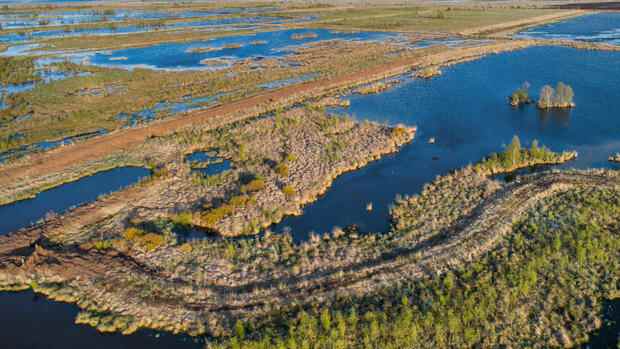Peatlands can bind carbon dioxide from the atmosphere and store it in the long term.
(Photo: imago images/blickwinkel)
Berlin In an action program for natural climate protection, Federal Environment Minister Steffi Lemke (Greens) outlined how the government wants to counteract the twin ecological crises of global warming and species extinction.
Natural climate protection combines climate protection with nature conservation and ensures that the effects of the climate crisis are mitigated. The aim is to strengthen, restore and preserve ecosystems so that they remain climate protectors and habitats for plants and animals at the same time. The federal government is providing four billion euros for this by 2026.
“I want to make nature strong so that it can help us against the climate crisis,” said Lemke during a visit to the moor in the Möllner Seewiesen in Brandenburg.
Forests, meadows, soil and moors, seas and bodies of water, semi-natural green spaces in the city and in the countryside: they can all bind carbon dioxide from the atmosphere and store it in the long term. They also act as a buffer against the effects of climate change, for example by keeping water in the landscape and providing cooling when it is hot.
Top jobs of the day
Find the best jobs now and
be notified by email.
Due to global warming, living conditions are changing so quickly that ecosystems cannot keep up and are becoming increasingly fragile. Some animal and plant species cannot adapt to the changed conditions and are dying out. Conversely, degrading ecosystems quickly release the carbon that has been bound in them over thousands of years. The same thing happens with forest fires. This amplifies the climate crisis.
Anchored in the coalition agreement
The action program for natural climate protection, or ANK for short, is already anchored in the traffic light coalition agreement. According to the Ministry of the Environment, suggestions and ideas from other departments have already been incorporated into this first draft.
“I want to make nature strong so that it can help us against the climate crisis,” said Lemke.
(Photo: dpa)
In a next step, countries, associations and citizens will have the opportunity to comment on the draft from September 5th. After evaluating the feedback, the program will be revised, finalized within the federal government and decided by the cabinet at the beginning of 2023.
The Union in the Bundestag criticized the program. “Natural climate protection is an essential building block for achieving our climate goals,” said environmental policy group spokeswoman Anja Weisgerber (CSU) of the German Press Agency.
However, Lemke’s draft does not defuse the conflict of objectives between more and more area protection on the one hand and areas for food production on the other. Weisgerber warned that more food would have to be imported in the future due to set-aside land.
64 measures in ten fields of action
Financing comes largely from the Climate and Transformation Fund. The focus is on renaturation measures and incentives for climate-friendly and nature-friendly forms of management. 64 measures are currently planned in ten fields of action, including:
• wet bogs: Peatlands are important as habitats for animals and plants and as carbon sinks, but 92 percent of peat soils are currently drained and cannot fulfill these functions. In Germany, this releases 53 million tons of carbon dioxide into the atmosphere every year. Drained bogs should therefore be rewetted.
• restore flood plains: Intact floodplains serve as flood protection and also protect against droughts. They keep water in the landscape.
• promote forests: Forests are the largest land-bound greenhouse gas sink in Germany, which means they bind large amounts of CO2, are habitats for animals and plants, improve the local climate and retain water in the landscape. Forests should therefore be converted and expanded.
• Making cities and communities climate-proof: Nature in cities and settlements provides better air, provides shade and cools on summer days. Coherent natural green areas form cold and fresh air corridors and offer many animal species a place to live and retreat. For example, the ANK supports the planting of 150,000 additional city trees by 2030.
No free pass
Environmental groups praise the project. Olaf Bandt, Chairman of the German Association for the Environment and Nature Conservation (BUND), said it was right to finally start restoring endangered habitats in Germany.
Bogs are important as habitats for animals and plants and as carbon stores, so drained bogs should be rewetted.
(Photo: imago images/blickwinkel)
But nature cannot do it alone. The action program is not a carte blanche. It does not release from the necessary task of ensuring fewer greenhouse gases in transport, in industry or in the building sector.
The WWF is concerned that the program currently only provides funding for three years. However, areas required for climate protection would have to be secured permanently.
More: On the road with Steffi Lemke – the otherwise rather reserved minister thrives on these keywords
